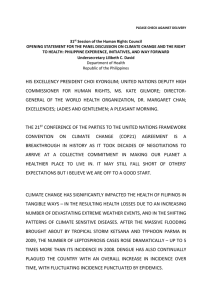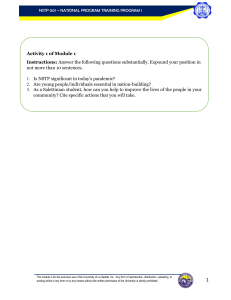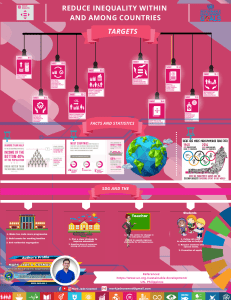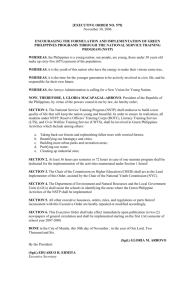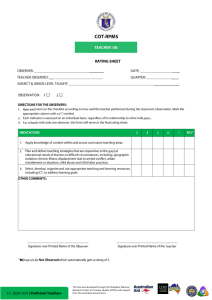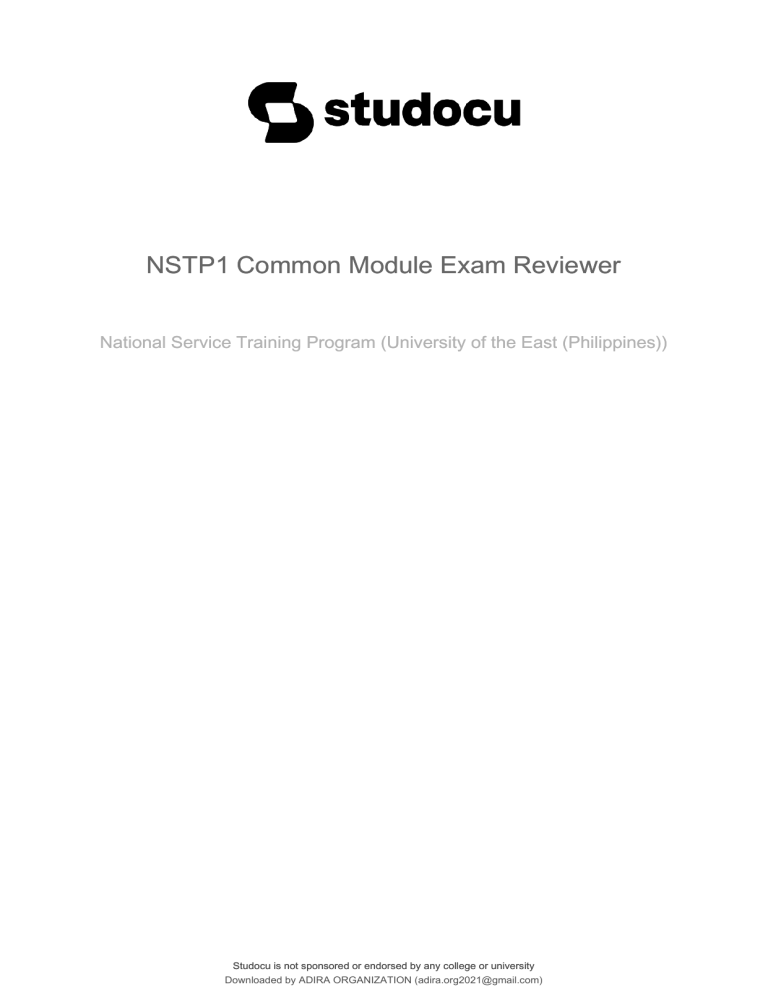
lOMoARcPSD|30858190 NSTP1 Common Module Exam Reviewer National Service Training Program (University of the East (Philippines)) Studocu is not sponsored or endorsed by any college or university Downloaded by ADIRA ORGANIZATION (adira.org2021@gmail.com) lOMoARcPSD|30858190 STL 1101-1P REVIEWER FOR CME ON NOVEMBER 06, 2021 UE National Service Training Program Chapter 1 – 6 Reviewer Chapter 1 – ORGANIZING STUDENTS THROUGH COURSE ORIENTATION The 1987 Philippine Constitution Article 1. The Philippine Preamble (The introduction of the 1987 Philippine Constitution) <We, the sovereign Filipino people, imploring the aid of Almighty God, in order to build a just and humane society, and establish a Government that shall embody our ideals and aspirations, promote the common good, conserve and develop our patrimony, and secure to ourselves and our posterity, the blessings of independence and democracy under the rule of law and a regime of truth, justice, freedom, love, equality, and peace, do ordain and promulgate this Constitution=. Article II – <Declaration of Principles and State Policies= Article III – <Bill of Rights of every Filipino citizen=. Article IV – <Citizenship= Article V – Suffrage= (The presence of election through popular will) NSTP Common Module is all about enhancing Awareness of Social Issues and Problems. It is the focus of the revised NSTP-IRR mandates the implementation minimum standards for NSTP. It covers the following topics: 1. Enhancing Awareness of Social Issues and Problems 2. Citizenship Training 3. Drug abuse and its Prevention 4. Disaster Management 5. Environmental awareness and protection 6. National Security Concerns and Peace Education 1 Downloaded by ADIRA ORGANIZATION (adira.org2021@gmail.com) lOMoARcPSD|30858190 National Service Training Program (NSTP) – Aimed at enhancing civic consciousness and defense preparedness in the youth by developing the ethics of service at patriotism. - It is also designed to motivate, train, organize and mobilize tertiary level students for national defense preparedness. - Implemented S.Y. 2002 - 2003 - It has 3 program components. - The foreign students are exempted undergoing this program. - An NSTP office is headed by a coordinator. - The NSTP Law is also known as Republic Act No. 9163. - CHED, TESDA and DND are the leading agencies that issue, adopt, and promulgate the implementing Rules and Regulations of NSTP. - Certificate of Completion is to be awarded to NSTP students who have successfully complied with the program requirements. Program Components of the NSTP 1. The Reserved Officers’ Training Corps (ROTC) - Design to provide military training to tertiary level students - graduates of ROTC component belongs Department of National Defense (DND) - While the graduates of Non-ROTC components belongs National Reserve Corps (NRC 2. The Literacy Training Service (LTS) - Serves to train the students to teach literacy and numeracy to school children and out of school youth. 3. The Civic Welfare Training Service (CWTS) - Design activities that will contribute to the general welfare and betterment of life for the community. Immersion – This refers to an act involving a wide range of activities including traditional forms of mutual aid and developmental interventions that provides and enabling and empowering environment both on the part of the beneficiaries and the volunteer rendering the act. Ester A. Garcia – Former CHED Chairperson who conceptualized the NSTP Act of 2001. Gloria Macapagal-Arroyo – Is the former President who have signed and approved the NSTP Law. 2 Downloaded by ADIRA ORGANIZATION (adira.org2021@gmail.com) lOMoARcPSD|30858190 Chapter 2 – CITIZENSHIP and GOOD GOVERNANCE Republican Government – It is a democratic government by representatives chosen by the majority of the people. Sovereignty – A country’s independent authority and the right to govern itself. Nationalism – Refers to a feeling that people have of being loyal to and proud of their country. Patriotism – refers to love that people feel for their country Triangular Seal – The great seal which bear the words <Republika ng Philipinas= and the National Motto. Citizens – Inhabitants of a city or town, or natives or naturalized members of a state or nation who owe allegiance to its Government and are entitled to its protection and privileges. - It is the nation’s most valuable resources and asset. - On their hands lies the success of our country to be strong nation. - Their duty is to defend the security and promote the general welfare of the State. Citizenship – A term denoting membership of a citizen in a political society. Functional Citizens – are empowered individuals who can protect, promote welfare and equality, justice and truth, freedom and peace of the country. Youth – They are needed to be trained and be developed so they may be able to perform their responsibilities as citizens. Jus Sanguinis – Under this rule, blood relationship is the basis for the acquisition of citizenship. Jus Soli - Under this rule, place of birth is the basis for the acquisition of citizenship. Migrant – A citizen of a country who is residing in or passing through another country especially for work. Natural-born Citizens – Who at the moment of their birth are already citizens of the Philippines. Naturalization – An act of formally adopting a foreigner into the political body of the state and clothing him with the rights and privileges of citizenship. The National Motto : MAKA-DIYOS, MAKATAO, MAKAKALIKASAN at MAKABANSA Civilian Authority – At all times, supreme over the military. AFP – The protection of the citizen and the State Miranda Rights – < Any person under the investigation for the commission of an offense shall have the right to be informed of his right to remain silent and to have competent and independent counsel preferably of his own choice=. 3 Downloaded by ADIRA ORGANIZATION (adira.org2021@gmail.com) lOMoARcPSD|30858190 Right to Due Process – Is the right gives to every accused individual the right to undergo trials and be heard. Morality – A social system that shares a set of common values. Values – broad preferences concerning appropriate courses of action or outcomes. Culture – a social system that shares a set of common values, in which such values permit social expectations and collective understanding of the good, beautiful and constructive. Behavioral values – inner personal responses or incentives which prompt a person to act in a certain way. Cultural Values – are modes of conduct of a group or society. Characteristics of Cultural Behavioral Values 1. Subjective 2. Societal 3. Situational Volunteerism – Refers to an act involving a wide range of activities, including traditional forms of mutual aid and developmental interventions that provide an enabling and empowering environment. Volunteer – refers to an individual or group who contribute time,, service and resources whether on full time or part time basis. Volunteering – practice of people working on behalf of others without being motivated by financial or material gain. Volunteer Service Organization – refers to a local or foreign group that recruits, train, deploy and support volunteer workers to programs and project implemented by them. Voluntary Sector – refer to those sectors in the Philippine society that organize themselves into volunteers to take advocacy and action primarily for local and national development as well as international cooperation and understanding. Universal Human Rights – provides ways and practices to strengthen and inculcate the essence of volunteerism. About Philippine Flag: • Feeston shall mean to hang in a curved shape between two points as a decoration. • Fly shall mean the part of the flag outside the hoist or lengths. • Symbol shall mean any conventional sign, which reveals man’s achievement and heroism 4 Downloaded by ADIRA ORGANIZATION (adira.org2021@gmail.com) lOMoARcPSD|30858190 • Half Mast refers to the lowering of the Philippine flag to one-half the distance between the top and bottom of the staff. • Hoist the part of the flag nearest the staff of the canvass to which the halyard is attached. The National Flag should be/have; ➢ Displayed in all public buildings, official residences, public plazas, and institutions of learning. ➢ Proper illumination at night. ➢ If flown from a flagpole; blue color above for peace and red for war ➢ Solemnly burned when worn out. ➢ Raised at sunrise and lowered at sunset. ➢ Hoisted to the top briskly and lowered ceremoniously. ➢ In front of the center of the line when carried in a parade. ➢ Hoisted first and lowered last if displayed with another flag. ➢ Flown at half-mast as a sign of mourning 5 Downloaded by ADIRA ORGANIZATION (adira.org2021@gmail.com) lOMoARcPSD|30858190 Chapter 3 – DRUG ADDICTION AND PREVENTION Drug dependence – the ultimate disastrous consequence of drug abuse Physical dependence – other term is drug addiction Psychological dependence - known as drug habituation Phases of Drug Dependence 1. Experimental phase 2. Occasional or social use 3. Regular use 4. Drug dependence Classification of Dangerous Drugs 1. Marijuana (cannabis sativa L) Psychoactive component is delta – 9 tetrahydrocannabinols. 2. Inhalants – drugs that breathe into the lungs. 3. Stimulants – drugs that makes a person more active and gives more energy. 4. Depressants – a chemical substance that makes a body less active. 5. Hallucinogens – a substance that causes people to see or sense things that are not real. 6. Narcotics – drug that affects the brain and is given to people in small amount to make them sleep or feel less pain. Weapons to combat drug menace 1. Responsible parents 3. Mass Media 2. Drug Abuse Awareness and Education 4. Treatment Programs Parent Involvement – It is encouraged to support children’s learning of pro-social activities at home. 6 Downloaded by ADIRA ORGANIZATION (adira.org2021@gmail.com) lOMoARcPSD|30858190 Chapter 4 – DISASTER MANAGEMENT Disaster – A serious disruption of the functioning of a community or a society involving widespread human, material, economic or environmental losses and impacts, which exceeds the capability of the society to cope using its own resources. - <a serious disruption of the functioning of a community or a society causing widespread human, material, economic or environmental losses.(UN) Catastrophe – This is the most severe category of natural and man-made disasters. Natural Disaster – a major adverse event resulting from natural processes of the earth. - Are extreme, sudden events caused by environmental factors that injure people and damaged property. Earthquake – A shaking of a part of the earth’s surface that often causes great damaged. (the geographical location of the Philippines has series of interconnected plates which made vulnerable to different kinds of natural disasters is known as the Pacific Ring of Fire) Landslide – a large mass of rocks and earth that suddenly and quickly moves down the side of a mountain or hill. Typhoon – an extremely large, powerful, and destructive storm. Flood – a large amount of water covering an area of land that is usually dry. Drought – This is a natural disaster which refers to unusual dryness of soil resulting in crop failure and shortage of water for other uses, caused by significantly lower rainfall than average over a prolonged period. Volcanic Eruptions – happen when molten rocks ash, and gas are discharged from volcanic vent. Human-made Disaster – refer to human induced treat or deliberate intent of negligent human actions that injure people and damaged property. Stampede – an occurrence in which a large group of frightened or excited animals or people run together in a wild and uncontrolled way to escape from something or get out of a place. 7 Downloaded by ADIRA ORGANIZATION (adira.org2021@gmail.com) lOMoARcPSD|30858190 (Air and water pollution, Industrial accidents, Fire, Civil Disturbances, War, Poverty, Bomb treats and accident) Transportation and Communication – Are the important services that be commonly disrupted when calamities occur. Risk – the probability that a disaster will occur Hazard – the specific nature of a treat Vulnerability – the inability to withstand, protect oneself or recover rapidly from a potentially damaging event Prevention – measures designed to avert potential hazard. Preparedness – measures that ensure an effective disaster response. Mitigation – measures that reduce the harmful effects of a disaster. Response – actions taken in the aftermath of a disaster to assist victims and rehabilitate society National Disaster Risk Reduction Management Council (NDRRMC) – Is an agency of the Philippine government under the Department of National Defense, responsible for ensuring the protection and welfare of the people during disasters or emergencies. Pre-Disaster Planning – These are pre-disaster actions and measures being undertake within the context of disaster risk reduction and management. Relief Operation and Goods Distribution – The response phase during disasters and calamities usually commences with. Post Disaster Recovery – It is called the restoration and improvement Rehabilitation – These are measures that ensure the ability of affected communities/areas to restore their normal level of functioning National Service Training Program, Secondary and Tertiary Level – Are the levels of education which the curricula in integration of the disaster risk reduction management education are being taught. Civil Service – This is a kind of disaster preparedness and prevention activities other than military actions, geared towards the reduction of loss of life and property brought about by natural and human-induce-disasters. 8 Downloaded by ADIRA ORGANIZATION (adira.org2021@gmail.com) lOMoARcPSD|30858190 First Aid Kit –It refers to a collection of supplies and equipment for use in giving initial care for illness or injury. Pandemic – These emergencies involve a sudden onset of contagious disease that affects health but also disrupts services and businesses, bringing economic and social costs. National Calamity Fund (NCF) – the government’s primary fund for responding to disasters which is intended to supplement and compliment Local Calamity Fund. Local Calamity Funds (LCF) – This refers to the 5% allocation on annual revenues of the local government activities specifically for post-disaster activities. State of Calamity – It is a condition involving mass casualty and/or major damages to property, disruption of means of livelihood, roads and normal way of life of people in the affected areas as a result of the occurrence of natural and human-induced hazards. Non-Governmental Organizations (NGOs) – This refers to an organized entity that is functionally independent of, and does not represent a government or state. This tern is normally applied to organizations devoted to humanitarian and human rights causes. Philippine Red Cross (PRC) – Is a local-based agency involved in wider array of humanitarian services which include but not limited to blood and in disaster-related activities. Some Destructive Natural/Human-Made Disasters Luzon Earthquake in July 1990 Philippines that took 1,293 lives and 12.2 billion damaged property. Mt. Pinatubo Eruption in the Philippines on July 1991 that affected the 340,00 km 2 of agricultural land, 600,00 job lost, 847 people dead, 184 injured, 23 missing, and more than 1 million people displaced. ORMOC Flashflood , November 1991 Ozone Disco Tragedy , March 18, 1996 ( 162 people were burned dead) Marcopper Mining Disaster in Marinduque, March 24, 1996 (one village to be buried and 400 families to be displaced) H1N1 – A virus strain or flue pandemic in the Philippines in 2009 is part of the larger global flu epidemic that involves new influenza A. Rizal Day Bombing in December 2000 (11 were killed and 19 injured) Wowowee Stampede in PhilSport Stadium , February 4, 2006 (73 people dead and 400 injured) 9/11-Attack at World Trade Center USA , September 11, 2001 ( Earthquake and Tsunami hit in Sukuiso Japan, March 2011 9 Downloaded by ADIRA ORGANIZATION (adira.org2021@gmail.com) lOMoARcPSD|30858190 Terrorist Attack in France November 13, 2015. Deadly Typhoons in the Philippines: (Average of 20-30 per year) Typhoon <Uring= (Thelma – international name) , November 1991 (cause of Ormoc City tragedy) Typhoon <Caloy= (Chanchu – international name) , May 2006 Typhoon <Juan= (Saomai – international name) , August 2006 (most powerful typhoon on record in China) Typhoon <Milenyo= (Xangsane – international name) , September 2006 Typhoon <Reming= (Durian – international name) , December 2006 Typhoon <Ondoy= (Ketsana – international name), September 2009 Typhoon <Habagat= (Haikui – international name), August 2012 Typhoon <Yolanda= (Haiyan – international name), November 2013 Typhoon <Glenda= (Rammasun – international name) , July 2014 10 Downloaded by ADIRA ORGANIZATION (adira.org2021@gmail.com) lOMoARcPSD|30858190 Chapter 5 – ENVIRONMENTAL AWARENESS AND PROTECTION Climate change – is the extreme weather condition over a long period of time. Deforestation – is the destruction of vast areas of forest through unsustainable forestry practice without plant new growth. Waste Management – is the proper disposal of waste or garbage materials. Water Scarcity – is the limited access to potable water. Ecosystem – refers to functional units that result from interactions of abiotic, biotic and cultural components. Drought – This is a natural disaster which refers to unusual dryness of soil resulting in crop failure and shortage of water for other uses, caused by significantly lower rainfall than average over a prolonged period. Earthquake and Tsunami – These are the two most devastating natural calamities that hit in Japan 2011. El Niño – an irregularly recurring upwelling of unusually warm surface waters to the Pacific Ocean toward and along the western cost of Sout America that prevents upwelling of nutrient-rich cold deep water that disrupts typical regional and global weather patterns. Extreme el niño was an event that believed to have caused the eruption of Mt. Pinatubo La Niña – an irregularly recurring upwelling of unusually cold water to the ocean surface along the western cost of South America that often occurs following an El Niño and that disrupts typical regional and global weather patterns. Avalanche – a large amount of snow and ice or of dirt and rocks that slides suddenly down the side of a mountain. 11 Downloaded by ADIRA ORGANIZATION (adira.org2021@gmail.com) lOMoARcPSD|30858190 Chapter 6 – NATIONAL SECURITY CONCERNS AND PEACE EDUCATION National Security - is the requirement to maintain the survival of the state through the use of economic, power projection and political power and the exercise of diplomacy. Peace – is a state without war. Peace Education – Teaching how to develop a behavior that encourages harmony in the way people talk, listen, and interact with each other, and discourages actions to hurt, harm, or destroy each other. Peaceable School – It refers to a commitment to make school a place of peace as one of the ultimate challenges in education. Diplomacy – the art and practice of conducting negotiations among representatives of groups or states. Communication – The peaceful exchange of information and the sharing of feelings, decisions, and ideas. Family – A basic autonomous social institution. Social Justice – The State must give preferential attention to the welfare of the less fortunate members of the community – the poor, the unschooled, the disabled, the underprivileged – those who have less in life. Private Sector – They are the key actor in the realm of the economy where the central social concern and process are the mutually beneficial production and distribution of goods and services to meet the physical needs of human beings. Public Sector Employees – They are referred to as all persons in the civil service. Foreign Policy – The basic direction underlying the conduct by a State of its affairs vis-à-vis those of other states. International Law – Refers to the body of rules and principles which governs the relations of nations and their respective people in their intercourse with one another. 12 Downloaded by ADIRA ORGANIZATION (adira.org2021@gmail.com) lOMoARcPSD|30858190 ACCRONYMS and Its Definition • NSTP – National Service Training Program • ROTC – Reserve Officers Training Corps • LTS – Literacy Training Service • CWTS – Civic Welfare Training Service • OECO – Office of the Extension and Community Outreach • CHED – Commission on Higher Education • TESDA – Technical Education and Skills Development • DND – Department of National Defense • PASUC – Philippine Association of State Universities and Colleges • COCOPEA – Coordinating Council of Private Educational Associations of the Philippines • NGOs – Non-Government Organizations • IRR – Implementing Rules and Regulation • NDRRMC – National Disaster Risk Reduction Management Council • PAGASA – Philippine Atmospheric, Geophysical and Astronomical Services • BFP – Bureau of Fire Protection • PHIVOLCS – Philippines Institute of Volcanology and Seismology • MGB – Mines and Geosciences Bureau • DOTC – Department of Transportation and Communication • DPWH – Department of Public Works and Highways • DENR – Department of Environment and Natural Resources • MMDA – Metro Manila Development Authority • DSWD – Department of Social Welfare and Development • UNDRO – United Nations Disasters Relief Office Republic Act Known as RA No. 7077 Citizen Armed Forces of the Aims to organize, train, and develop and maintain Philippines Reservist Act Objective a support unit to the AFP of the Phil. to help protect our country and citizens in the event of war, invasion or rebellion. RA No. 9163 The NSTP Act of 2001 Design to recover the youth’s sense of patriotism and national pride, values and habits of discipline 13 Downloaded by ADIRA ORGANIZATION (adira.org2021@gmail.com) lOMoARcPSD|30858190 and hard work, integrity and accountability for nation building. RA No. 8491 The Heraldic Code of the This law requires due respect at all times for the Philippines Philippines’ national flag, national anthem and national symbols. P.D. No. 1706 The National Service Law < Every citizens must render services for its country like; civil welfare service, law enforcement service and military service= RA No. 9418 The Volunteer Act of 2007 To promote participation of various sectors of the Filipino society and the international organization in public and civic affairs. Executive Green Philippines Program Aims to revitalize Philippine ecosystem with a 3- Order 579 By Pres. GMA fold objectives: Recycle, Replenish and Revitalize. RA 9512 National Environmental Declaration of month of November as an (12-12-2008) Awareness and Education <Environmental Awareness Month= throughout the Act of 2008. Philippines. Known as DRRM Law Aims to strengthen the Philippines’ Disaster Risk (11-30-2006) RA 10121 Reduction and Management System. US National Security Act of Advice the US president on the integration of 1947 domestic, military and foreign policies relating to national security. Dear class, Good Luck to your NSTP Departmental Examination on November 6, 2021. Please come on time and ready your Internet connectivity. I will meet you in Google Meet at 1:00 PM. Please prepare a back-up in case you’ve lost connection. Late comers will not be allowed to take the Examination so be mindful with the time. Thank you and God Bless☺ 14 Downloaded by ADIRA ORGANIZATION (adira.org2021@gmail.com)


